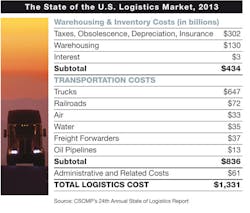Supply Chain & Logistics: Government Oversight Making It Tougher for Manufacturers to Keep On Trucking
For U.S. manufacturers, the idea of logistics is nearly synonymous with trucking, which is hardly surprising considering that roughly 70% of all goods are transported on a truck, and nearly 80% of all transportation costs are spent on motor carriers. With so much of the economy dependent on trucks, you might think that ensuring the viability of the trucking industry would be a priority for politicians, but of course nothing is ever that simple.
For one thing, trucks burn up a lot of fuel; some U.S. government studies estimate that motor carriers account for 20% of all the carbon emissions related to transportation. The Obama Administration has been particularly insistent on regulating greenhouse gas emissions from medium-duty and heavy-duty trucks. As a result, trucking companies have been purchasing new equipment (mostly to replace aging vehicles) to comply with the regulations, which has led to a declining number of vehicles on the road.
Exacerbating the situation is that "despite the shrinking fleets, carriers are still reporting difficulty finding enough drivers," reports transportation consultant Rosalyn Wilson, author of the annual State of Logistics Report, presented by the Council of Supply Chain Management Professionals (CSCMP) with support from Penske Logistics. The industry is already short by about 30,000 drivers, she points out, and the situation will get even worse when the new Hours of Service rules go into effect on July 1, 2013, which will reduce the number of hours a driver can be behind the wheel per day and per week.
See Also: Lean Supply Chain Logistics Best Practices
These new rules, Wilson observes, "could have the effect of a net 2% to 5% reduction in driver capacity, so projecting that out arrives at the need for another 100,000 drivers, and that's without an increase in [freight] volume."
There seems to be a disconnect within the U.S. Labor Department, Wilson says, which has forecast that truck drivers will account for 43% of the growth in logistics jobs in the coming years. "Where will these drivers come from?" Wilson wonders, pointing out the industry's rather dismal track record in recruiting younger people. "Truck drivers represent a job category with the fewest potential workers trained to fill them."
As capacity tightens for trucking, look for manufacturers to continue shifting some of their goods to the railroads. The amount spent on rail transportation in 2012 was up 4.9%, a healthy gain though nowhere close to the 16% increase that occurred in 2011. According to Wilson, however, don't look for a full-scale shift to consolidate logistics services across trucking, rail and ocean carriers due to potential government monopoly regulations.
| Learn what it takes to be one of the Top 25 Supply Chains at www.industryweek.com/supply-chain. |
Wilson characterizes the overall malaise settling over the economy—and particularly over the manufacturing and logistics industries—as the "new normal." In this not-so-brave new world, we will experience "less reliable or predictable freight service as volumes rise, but capacity will not increase fast enough to fully meet demand."
About the Author
Dave Blanchard
Senior Director of Content
Focus: Supply Chain
Call: (941) 208-4370
Follow on Twitter @SupplyChainDave
During his career Dave Blanchard has led the editorial management of many of Endeavor Business Media's best-known brands, including IndustryWeek, EHS Today, Material Handling & Logistics, Logistics Today, Supply Chain Technology News, and Business Finance. He also serves as senior content director of the annual Safety Leadership Conference. With over 30 years of B2B media experience, Dave literally wrote the book on supply chain management, Supply Chain Management Best Practices (John Wiley & Sons, 2010), which has been translated into several languages and is currently in its second edition. He is a frequent speaker and moderator at major trade shows and conferences, and has won numerous awards for writing and editing. He is a voting member of the jury of the Logistics Hall of Fame, and is a graduate of Northern Illinois University.

